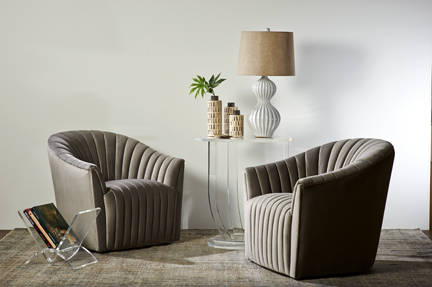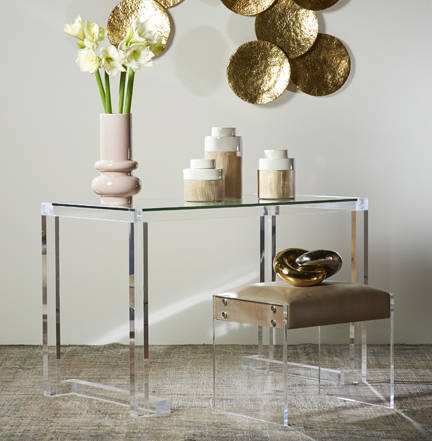Acrylic is back in style as designers find new ways to showcase it
Crystal clear acrylic is ideal for many purposes, most commonly as an alternative to glass due to its shatter resistance and lightweight properties. However, acrylic — or polymethyl methacrylate, as it is scientifically known — is just as popular in home furniture design, and that was the gospel being preached by Sean McFadden during January’s Las Vegas Market.
“Acrylic is greatly misunderstood,” said McFadden, vice president of Interlude Home. “The perception is that it’s just plastic, but it’s different and so much more than plastic. Interlude Home is a fashion-driven home furnishing company, and we follow fashion trends and bring those trends into the home. One of those trends is acrylic, where its eclectic mix and transitional style make it popular in any setting or space in someone’s home.
“Back in the 1970s and ’80s, it dominated the design scene, and artists and designers are convincing consumers to look closely at acrylic again. It’s family friendly and whimsical and is taking shape in tables, chairs, accessories and lighting.”
The production of acrylic plastic dates back to the 1930s, and today it is known by its many trade names, including Plexiglas, Acrylite, Lucite and Perspex. It is lightweight, transparent, durable and flexible with properties that make it an ideal alternative to ordinary glass.
It became a strategic material during World War II in airplane windshields and submarine periscopes. In the ’50s, it became a fashionably modern material in rings, handbags, chairs, tables and even beds, such as the illuminated Plexiglas bed in cosmetics icon Helena Rubinstein’s New York City apartment. Today, it is back in fashion as an eclectic and retro furniture addition to any room.
“The idea of using acrylic in furniture design took the country by storm when Helena Rubinstein commissioned Plexiglas furniture for her apartments,” McFadden said. “She had a Broadway set designer create a bedroom set, chairs and other items, and it was groundbreaking. The entire collection was a sensation and appeared in all the popular magazines at that time. It opened people’s eyes to this material and brought acrylic into the mainstream for home furnishings.”
According to McFadden, acrylic furniture has been hot and cold over the years but is popular again and being seen in a host of environments where it was previously confined to hard contemporary and high-rise city living. Designers are showing acrylic cocktail tables, side tables, lighting, chairs and dining tables, or they are using acrylic as accents, such as buttons or furniture legs.
“Acrylic is so contemporary looking, and designers want to demystify it and have permission to create their own space as they learn more about its use in furniture design,” McFadden said. “Designers use their imagination in working with the product because it is robust yet flexible.
“What gets lost in trying to explain acrylic to potential buyers is that acrylic requires a very high level of craft when done well. I describe it in the same category as wood in that it needs to be shaped, joined, polished and finished. It’s an art and a skill.”
An even more telling sign is the re-creation of traditional furniture using acrylic. There have been classic Chinese designs from the Ming Dynasty made in clear acrylic. Other designers have used reclaimed materials to create sustainable pieces that become the focal point in a room.
And that same acrylic is brought into today’s paints to make them more durable, stain resistant and long lasting. Acrylic is able to showcase details when mixed with other materials. It can sparkle with light as a reflective medium and can be used as a light redirecting source.
Maintaining acrylic is basic: Keep it dusted, and wipe it down with a microfiber cloth and water. Never use ammonia or any other type of chemical solvent. It is paintable, odorless and OSHA-classified as nonhazardous.
Ultraviolet light won’t break it down like plastic, and it will not become brittle and crack when left outside. Nor will it become yellow in direct sunlight. Another positive is that acrylic is always warm, because it’s a nonconductor of heat or cold.


















